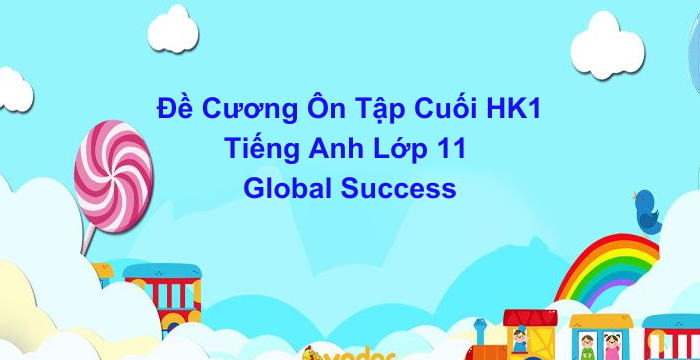Đề Cương Ôn Tập Cuối Học Kì 1 Tiếng Anh Lớp 8 Global Success (15.12.2024)
Thầy Thắng
ĐỀ CƯƠNG LỚP 8
15
Ngày đăng: 15-12-2024 17:13:11

ÔN TẬP CUỐI HỌC KỲ I
Trường THCS Lê Độ, TP Đà Nẵng, 2024 - 2025
I. Choose the word whose underlined port is pronounced differently from the others.
1. A. carrot B. city C. cake D. communal
2. A. age B. give C. garden D. guitar
3. A. keep B. know C. kitchen D. keen
4. A. activity B. pick C. city D. sit
5. A. cabbage B. orange C. hospitable D. cottage
6. A. chopstick B. chicken C. cheek D. character
7. A. thank B. thin C. tradition D. land
8. A. avoid B. soil C. choice D. choir
9. A. sing B. offering C. longevity D. language
10. A. good B. noon C. moon D. cool
11. A. future B. culture C. mature D. venture
12. A. tour B. scour C. sour D. hour
II. Choose the best answer to complete the sentences.
1. Minority groups have their own…………….…like the dan tinh, gong, t'rung.
A. folk songs B. musical instruments C. terraced fields D. communal houses
2. Many Asians go to Buddhist temples to…………..for good luck.
A. admire B. chase C. decorate D. pray
3. I'd prefer you not to make a………………of going to bed late.
A. habit B. craft C. lifestyle D. practice
4. Ethnic minority children learn how to………….clothing from an early age.
A. raise B. grow C. weave D. catch
5. We like that restaurant: it…………………..very delicious food.
A. buys B. cuts C. serves D. practises
6. People climb a seven-step……………..to enter this stilt house.
A. open fire B. staircase C. post D. wooden statue
7. The Vietnamese often prepare……….to worship their ancestors during Tet holiday.
A. a bamboo pole B. decorative items C. a communal house D. offerings
8. Buying……………….is a common practice in my city.
A. lifestyle B. tribal dances C. street food D. native art
9. We have a tradition of holding a…………….on the first day of Tet.
A. opening ceremony B. family reunion C. martial arts D. ornamental tree
10. I love mua sap, a popular……….of the Thai people.
A. folk dance B. musical instrument C. bamboo flute D. stilt house
11. Most families in……………Viet Nam prepare offerings for the Kitchen Gods.
A. the B. Ø C. a D. an
12. We went there by………….boat.
A. a B. an C. the D.ØT
13. The offerings include………..set of flowers and fruits, paper clothes and three carps.
A. a B. an C. the D. Ø
14. The Ok Oom Bok Festival takes place in…………October.
A. the B. An C. Ø D. a
15. Bat Trang Village is famous for………tradition craft of pottery making..
A. Ø B. a C. an D. the
16. Tet is coming. I see…………..flowers and ornamental trees everywhere.
A. a B. an C. the D. Ø
17. We only see…………………beautiful terraced fields here.
A. a little B. much C. many D. a few
18. Vietnam is a country with………….ethnic groups.
A. many B. much C. a little D. an
19. Trang: You really have a nice dress, Mai.
Mai:..................................................
A. Why do you say that? B. I'm glad you like it.
C. That's my strong point. D. I don't think so.
20. Hoa: You look nice today.
Liz:..................................................
A. I beg you bardon. B. I don't think so
C. Thank you, Hoa. D. Why do you say that?
III. VERB FORMS: Use the present simple, present continuous, past simple and future simple.
1. I usually………….(go) away at weekends.
2. The earth………..(go) round the sun.
3. Rice………….(not grow) in cold climates.
4. How often…………..you……………….(go) to the dentist?
5. Julie……………..(not drink) tea very often.
6. If I win the lottery, I…………………(buy) a big house.
7. 'Where's Mark?' 'He………………….(have) a shower.'
8. Let's go out now. It……………………..(not rain) any more.
9. What's all that noise? What……………(go) on?
10. I……………..(read) a really good book at the moment.
11. I……………………………(get) hungry. Let's go and eat.
12. Wolfgang Amadeus Mozart…………………(be) an Austrian musician and composer.
13. We…………………….(invit) them to our party, but they decided not to come.
14. The police……………………….(stop) me on my way home last night.
15. Laura……………..(pass) her exam because she studied very hard.
16. It was cold, so I ……………(shut) the window.
17……………..you…………………(have) time to do the shopping?' 'No, I didn't.'
18. They……………..(not invite) us to the party, so we didn't go.
19. 'Did you phone Lucy?' 'Oh no, I forgot. I……………..(phone) her now."
20. What……………..you……………..(do) if there is a fire in the building.
IV. WORD FORMS: WRITE THE CORRECT FORM OF THE WORDS IN BRACKETS
1. If you go climbing outdoors, it is a great way to increase your…….(strong)
2. Knitting makes people be more careful and………………..(patience).
3. I usually read books when I have free time,...............at the weekend. (especial)
4. The leisure activity I like best is……………..(volunteer).
5. Many people take a class to learn how to climb and use their equipment…..(effect).
6. The young use netlingo to……………on the internet. (society)
7. Will your parents be…………………with your good school results? (satisfy)
8. People here live by……………………fish from nearby lakes and ponds. (catch)
9. The driver………the rice from the back of the truck yesterday. (load)
10. Travelling up the mountain, people stop and take photos of the…..scenery. (picture)
11. The local people are kind and…………………..to visitors. (hospitality)
12. Today it's raining………………...than it was yesterday. (heavy)
13. The workers arrived………………..than my dad expected. (early)
14. The children are always busy……………their parents. (help)
15. We also have………………..from our parents and friends. (press)
16. The club leaders will provide us with a…………..of activities. (various)
17. Do you find the club activities……………………? (enjoy)
18.Every ethnic group has their own……………culture. (tradition)
19. What is the name of a popular Tay's……………..instrument?- B: It's dan tinh. (musical)
20.These…………….houses are the largest and tallest ones in the village. (community)
21. It's a tradition for shops to have a lion dance……….at their opening ceremony. (perform)
22…...the Vietnamese prepare offerings to worship their ancestors during Tet.(Tradition)
23.I think we should buy this ……….tree. (ornament)
24.My mum made the spring rolls for the……….party. (long)
25…………..can participate in games, watch traditional fashion shows. (visit)
26. They should not wear shorts or……………… shirts when attending the religious ceremony. (sleeve)
27. Kien was so tall that no one recognised him at the family…….. last summer. (union)
28. My mum puts in a lot of effort to prepare…………to worship our ancestors. (offer)
29. The festival……………..gathered on the riverside to cheer the boat racers. (go)
30. These days, many…………..write emails instead of letters. (teen)
31. Why do you choose to………..in that club? (participation)
V. Reading
1. Fill in each blank with a word from the box.
activities presentation water-throwing tradition fortune
Celebrations festival enjoyment heat wishes
Thai New Year (Songkran Festival)
The traditional Thai New Year is celebrated in April each year. Thailand adopted this (1)........with the belief that the sun re-entered. Aries and finished its orbit round the earth on April 13. In Thailand, this (2).............. is celebrated for three days from April 13 to April 15. Before the (3)..............., people will clean their houses in the hope of casting away any bad luck of the old year, so that good (4)............. will enter their new lives instead. Food and sweets will be prepared in advance for merit………………making and for treating guests.
The Songkran celebrations will begin with food (5).............to the monks who will walk along the streets in the early morning to receive food and other offerings. One of the most popular (6)...................for young
people is to convey their best (7).........................to their elders by pouring water onto them or their palms. After this, it is time for children and young people to have full (8)...........with water-throwing, dancing and folk games.
Do not expect to escape the (9)............................ activities, these take place on every street in Thailand. They can be a welcome break to the (10).......................of the dry season, but if you wish to stay dry it is best to stay indoors!
2. Fill in each blank with a word from the box.
Importance after there arrange because
ancestors responsible by look more
Marriage and family are very important in Viet Nam. In the countryside, parents often (1)............. marriages; divorce remains uncommon, though is (2)............. frequent in cities. In traditional Vietnamese families, roles are rigid. The man of the house is primarily (3)....................... for the family's economic well-being. Older children help to (4).................................after younger siblings. Discipline is viewed as a parental duty.
The woman of the house looks (5)..........................her parents, husband and children. In rural areas, women also do much agricultural work. Vietnamese women live (6)...............the "four virtues": hard work, beauty, refined speech and excellent conduct.
The Vietnamese attach great (7)............................to two traditional family obligations: to care for their parents in their old age and to worship them after death. In each Vietnamese family, (8)....................is at least one altar on which there are the pictures of their ancestors. Family members worship their ancestors (9)........................... they think parents after death will go to live in another world and this altar is the place where the ancestors' souls live in. As a result, every day Vietnamese people lay flowers or sometimes fruits on the altar for the belief that those (10).................. will enjoy them.
3. Read the following text, and fill in the blanks with the suitable words given
built year that located
houses history which opened
Duong Lam Village is (1)....................in Duong Lam Commune at a 45 km distance from Ha Noi. It is the birthplace of two kings in the (2)........................of Vietnam, Phung Hung (or Bo Cai Dai Vuong) and Ngo Quyen, who (3).....................up the long-term self-control and independence period of Viet Nam after Bach Dang Victory in the (4)........... 938.
All houses, gates, village gates and wells are (5)............of laterite creating an architectural complex, a unique village (6).............................is typical for villages in the midlands in the North of Vietnam.
At present, there are still nearly old 200 (7)........................and many other historical monuments such as Phung Hung Temple, Ngo Quyen Royal Tomb, Mong Phu Communal House, Ho Gam Hill at (8)..................... Phung Hung killed tigers to rescue villagers and the temple at which the diplomat Giang Van Minh is worshiped.
4. Read the passage and then answer the questions.
The Hmong people are one of the major ethnic minorities of Vietnam, with a population of about one million. Like many other ethnic groups, each year, the Hmong celebrates New Year with ritual practices for the gods and celebrations among themselves. The Hmong people celebrate their New Year festival following their own calendar. It usually falls between the eleventh month and the twelfth month of the Lunar calendar and lasts for at least fifteen days. However, it does not have an exact date every year. The date of New Year's Day is revealed some months prior to the celebration, and the festival is organized rather subtly. This is the most important festival of the year for them, symbolising the start of something new and good harvest for the coming year. People from many villages gather together and share their memories of the last year.
During the festival, there are various traditional musical shows that embody Hmong customs. Women and girls dress up in traditional costumes, wearing silver necklaces and diadems. Some other festive activities include tug- of-war and horse racing. They join with the Vietnamese (Kinh) Lunar New Year about a month later, when all the ethnicities also celebrate together.
- embody (v): tiêu biểu, biểu trưng
- diadem (n): vương miện
a. How often do the Hmong people celebrate their own New Year?
…………………………………………………………………………………………………..
b. How do the Hmong people celebrate their New Year?
…………………………………………………………………………………………………..
c. When does the Hmong's New Year festival take place?
…………………………………………………………………………………………………..
d. What does the Hmong's New Year festival symbolize?
…………………………………………………………………………………………………..
5. Read the passage and then answer the questions.
When mentioning Tet, the children normally think of "Li Xi". Giving each other best wishes and giving the children "Li xi" have become indispensable parts of Tet. Children are extremely happy and excited when receiving "Li Xi" from adults. "Li Xi" or lucky money is a small amount of money put in a red envelope which is given to children as a token of luck and best wishes. The old also get "Li Xi" from their children with a bless for a new year of health, peace and happiness. It is a common belief that the money can bring good fortune to the upcoming year. Traditionally, in the morning of the first day of Lunar New Year, children will visit their grandparents' home and give them wishes for good health and long life. It is the chance for the kids to show their respect and gratitude toward previous generations. After that, grandparents will give the children "Li xi" to welcome their new age. They also wish their grandchildren health, progress in study...
This traditional ritual still remains preserved until today; and "Li Xi" tradition has been an indispensable part of many generations' childhood. Although the amount of the money is small, the meaning that lucky money brings is very great. It not only presents the best wishes of the adults for the kids, but also demonstrates a succession of generations.
a. How do the children feel when receiving "Li Xi" from adults?
…………………………………………………………………………………………………..
b. What does "Li Xi" given to children at Tet represent?
…………………………………………………………………………………………………..
c. What will the children wish their grandparents?
…………………………………………………………………………………………………..
d. What does the tradition of giving "Li Xi" to children in families prove?
…………………………………………………………………………………………………..
6. Read the passage and then answer the questions.
VIETNAMESE COSTUME
The most recognisable traditional garment you're likely to see in Vietnam today is the ao dai, an item of national dress consisting of a long, tight-fitting, silk tunic worn over loose trousers. The design of the modern ao dai is a variation on more traditional forms of dress, and was perfected in the 1950s. Though it was banned in the late 1970s, the ao dai has since seen a resurgence and many women in Vietnam continue to wear it, often as part of a uniform for schools, universities and public service roles.
The male equivalent of the ao dai is called the ao gam, and is a brocade tunic ordinarily worn only on special occasions, such as birthdays or festivals. You are less likely to see the ao gam than the ao dai in a day-to-day setting in Vietnam.
More well-known even than the ao dai, the non la is a style of Vietnamese conical hat that has become symbolic not just of Vietnam but of East Asia in general for many Westerners. The hat, which is usually made from bamboo or straw, appears in Vietnamese art dating from 2,500-3,000 years ago, and is considered part of modern
Vietnamese national costume.
From the early twentieth century onwards, most Vietnamese have worn Western-style clothing in day-to-day life, while members of minority ethnic groups in the north of country still commonly wear the traditional dress of their own particular locality.
a. What's the most recognisable traditional garment in Vietnam?
………………………………………………………………………………………………..
b. What is the male equivalent of the "Ao dai"?
………………………………………………………………………………………………..
c. What is the "non la" made from?
………………………………………………………………………………………………..
d. What have Vietnamese women worn since the early twentieth century?
………………………………………………………………………………………………..
VI. Writing
A. Underline and correct the mistake in each sentence.
1. Xo Dang man are good at architecture, sculpting, and paint.
2. A big stilt houses stands on high posts.
3. Phong has to study harder, but he may fail the exam.
4. Much people in remote areas travel on foot.
5. Most minority women weave clothes and do houseworks.
6. They spend a lot of time surfing the net; although, they have little time to read books.
7. Mai is very sensitive, for don't comment on her new hairstyle.
8. The airs becomes thinner when you go higher up the mountains.
9. We don't cheat on exams, and it is a wrong thing to do.
10. I did a lot of homeworks in the evening.
B. Rearrange the words and phrases to make complete sentences.
1. Mua Sap / Is / Thai people / a / of / the north / folk dance / in / popular /?
………………………………………………………………………………………………..
2. Families / live / Do / growing / many / by / fruit trees / the orchards / in /?
………………………………………………………………………………………………..
3. faster / than / Can / that field / a machine / plough / a buffalo /?
………………………………………………………………………………………………..
4. ethnic minorities /often / Do / the / in / mountainous areas / live /?
………………………………………………………………………………………………..
5. the population / Is / 1.7 million / about / the Tay / of / ethnic group /?
………………………………………………………………………………………………..
C. Build the sentences with the cues given.
1. Phong / fancy / snowboard / because / it / improve / physical health.
………………………………………………………………………………………………..
2. Elly / be / fond of / hang out / her friend / after school.
………………………………………………………………………………………………..
3. your sister /enjoy / go / the cinema / this weekend?
............................................................................................................
4. My friends / keen / do karate / and / they / go / karate club / every Saturday.
.............................................................................................................
5. My cousin / not like / do DIY / because / he / not creative enough.
.............................................................................................................
D. Make a question for the underlined part.
1. Of 54 ethnic groups in Viet Nam, the Kinh is the largest?
.............................................................................................................
2. This dish is called five-coloured sticky rice because it has five colours: red, yellow, green, purple and white.
.............................................................................................................
3. There are 54 ethnic groups in Viet Nam.
.............................................................................................................
4. The H'Mong people wear a V-shaped front collar T-shirt.
.............................................................................................................
5. The Dao live mainly in the northern mountain provinces of Cao Bang, Ha Giang, Lao Cai, Yen Bai, Lai Chau and Tuyen Quang and the midland provinces of Phu Tho, Vinh Phuc and Hoa Binh.
.............................................................................................................
6. The Dao ethnic group has a total population of nearly 1 million people.
.............................................................................................................
7. I once saw a bamboo house on high posts in a travel brochure.
...................................................................................................................
8. The distance between Ha Noi and Ha Giang is 104 km.
.............................................................................................................
9. The Ede's harvest festival is usually held in October.
.............................................................................................................
10. The Thai hold ceremonies to worship their ancestors annually.
.............................................................................................................
11. The visitors got to Sila village on foot.
.............................................................................................................
12. The Katu are very friendly and simple.
.............................................................................................................
13. Their traditional dances are the tung tung for males and the ya ya for females.
.............................................................................................................
14. Pao spent three months making this musical instrument.
.............................................................................................................
E. Rewrite the following sentences using the words in brackets.
1. The teacher will be furious if you don't do the homework. (UNLESS)
.............................................................................................................
2. If she doesn't wear warm clothes, she will catch cold. (WEARS)
.............................................................................................................
3. Listen to the teacher carefully, or you won't understand the lessons. (UNLESS)
.....................................……………………………………………………………………….
4. They will have a pool party unless it rains. (IF)
……………………………………………………………………….
5. Take a taxi, or we will be late for the meeting. (DON'T)
……………………………………………………………………….
6. The baby will cry louder if they don't give him some toys. (UNLESS)
……………………………………………………………………….
F. Write a short paragraph (about 70-80 words) about.
a. An ethnic group in Vietnam you like
1. What the population of the ethnic group is
2. Where they live
3. What they do for a living
4. What their main food and drinks are
5. What their customs and traditions are
……………………………………
.……………………………………
….…………………………………
……………………………………
……………………………………
b. Write a short paragraph (about 70-80 words) about a local custom or tradition practiced in your hometown, using the following guiding questions: (1 m)
1. What is the custom/tradition?
2. Who practices it?
3. Where and when do people practice it?
4. What do people do?
5. Why do people practice that custom/tradition?
……………………………………
.……………………………………
….…………………………………
……………………………………
……………………………………
THE END
Giải đáp mọi thắc mắc trong đề vui lòng liên hệ Zalo: 034 8371 758
Theo dõi fanpage để cập nhật nhanh các bài tập và đề kiểm tra mới nhất.
https://www.facebook.com/profile.php?id=61555984765050
Bài Viết Liên Quan

Đề Cương Ôn Tập Cuối Học Kì 1 Tiếng Anh Lớp 8 Global Success (10.12.2025)

Đề Cương Ôn Tập Cuối Học Kì 1 Tiếng Anh Lớp 8 Global Success (10.12.2025)

Đề Cương Ôn Tập Cuối Học Kì 1 Tiếng Anh Lớp 8 Global Success (4.12.2025)

Đề Cương Ôn Tập Giữa Học Kì 1 Tiếng Anh Lớp 8 Global Success (28.11.2025)

Đề Cương Ôn Tập Giữa Học Kì 1 Tiếng Anh Lớp 8 Global Success (28.10.2025)

Đề Cương Ôn Tập Giữa Học Kì 1 Tiếng Anh Lớp 8 Global Success (22.10.2025)

Đề Cương Ôn Tập Cuối Học Kì 2 Tiếng Anh Lớp 8 Global Success (16.05.2025)

Đề Cương Ôn Tập Cuối Học Kì 2 Tiếng Anh Lớp 8 Global Success (18.04.2025)

Đề Cương Ôn Tập Cuối Học Kì 2 Tiếng Anh Lớp 8 Global Success (17.04.2025)

Đề Cương Ôn Tập Cuối Học Kì 1 Tiếng Anh Lớp 8 Global Success (07.01.2025)

Đề Cương Ôn Tập Cuối Học Kì 1 Tiếng Anh Lớp 8 Global Success (12.12.2024)

Đề Cương Ôn Tập Cuối Học Kì 1 Tiếng Anh Lớp 8 Global Success (10.12.2024)

Đề Cương Ôn Tập Giữa Học Kì 1 Tiếng Anh Lớp 8 Global Success (03.11.2024)

Đề Cương Ôn Tập Giữa Học Kì 1 Tiếng Anh Lớp 8 Global Success (28.10.2024)

Đề Cương Ôn Tập Giữa Học Kì 1 Tiếng Anh Lớp 8 Global Success (25.10.2024)

Đề Cương Ôn Tập Giữa Học Kì 1 Tiếng Anh Lớp 8 Global Success (24.10.2024)

Đề Cương Ôn Tập Cuối Học Kì 1 Tiếng Anh Lớp 8 Global Success (05.06.2024)

Đề Cương Ôn Tập Cuối Học Kì 1 Tiếng Anh Lớp 8 Global Success (05.06.2024)

Đề Cương Ôn Tập Giữa Học Kì 1 Tiếng Anh Lớp 8 Global Success (31.05.2024)

Đề Cương Ôn Tập Giữa Học Kì 1 Tiếng Anh Lớp 8 Global Success (31.05.2024)

Đề Cương Ôn Tập Cuối Học Kì 2 Tiếng Anh Lớp 8 Global Success (26.04.2024)

Đề Cương Ôn Tập Cuối Học Kì 2 Tiếng Anh Lớp 8 Global Success (25.04.2024)

Đề Cương Ôn Tập Cuối Học Kì 2 Tiếng Anh Lớp 8 Global Success (24.04.2024)

Đề Cương Ôn Tập Cuối Học Kì 2 Tiếng Anh Lớp 8 Global Success (22.04.2024)

Đề Cương Ôn Tập Cuối Học Kì 2 Tiếng Anh Lớp 8 Global Success (12.04.2024)

Đề Cương Ôn Tập Giữa Học Kì 2 Tiếng Anh Lớp 8 Global Success (14.03.2024)

Đề Cương Ôn Tập Giữa Học Kì 2 Tiếng Anh Lớp 8 Global Success 07.03.2024

Đề Cương Ôn Tập Giữa Học Kì 2 Tiếng Anh Lớp 8 Global Success 05.03.2024

Đề Cương Ôn Tập Giữa Học Kì 2 Tiếng Anh Lớp 8 Global Success 28.02.2024

Bài Đăng Gần Đây

Đề Kiểm Tra Cuối Kì 1 Tiếng Anh Lớp 9 Global Success (23.12.2025)

Đề Kiểm Tra Cuối Kì 1 Tiếng Anh Lớp 6 Global Success (23.12.2025)

Đề Kiểm Tra Cuối Kì 1 Tiếng Anh Lớp 7 Global Success (22.12.2025)

Đề Cương Ôn Tập Cuối Học Kì 1 Tiếng Anh Lớp 11 Global Success (20.12.2025)

